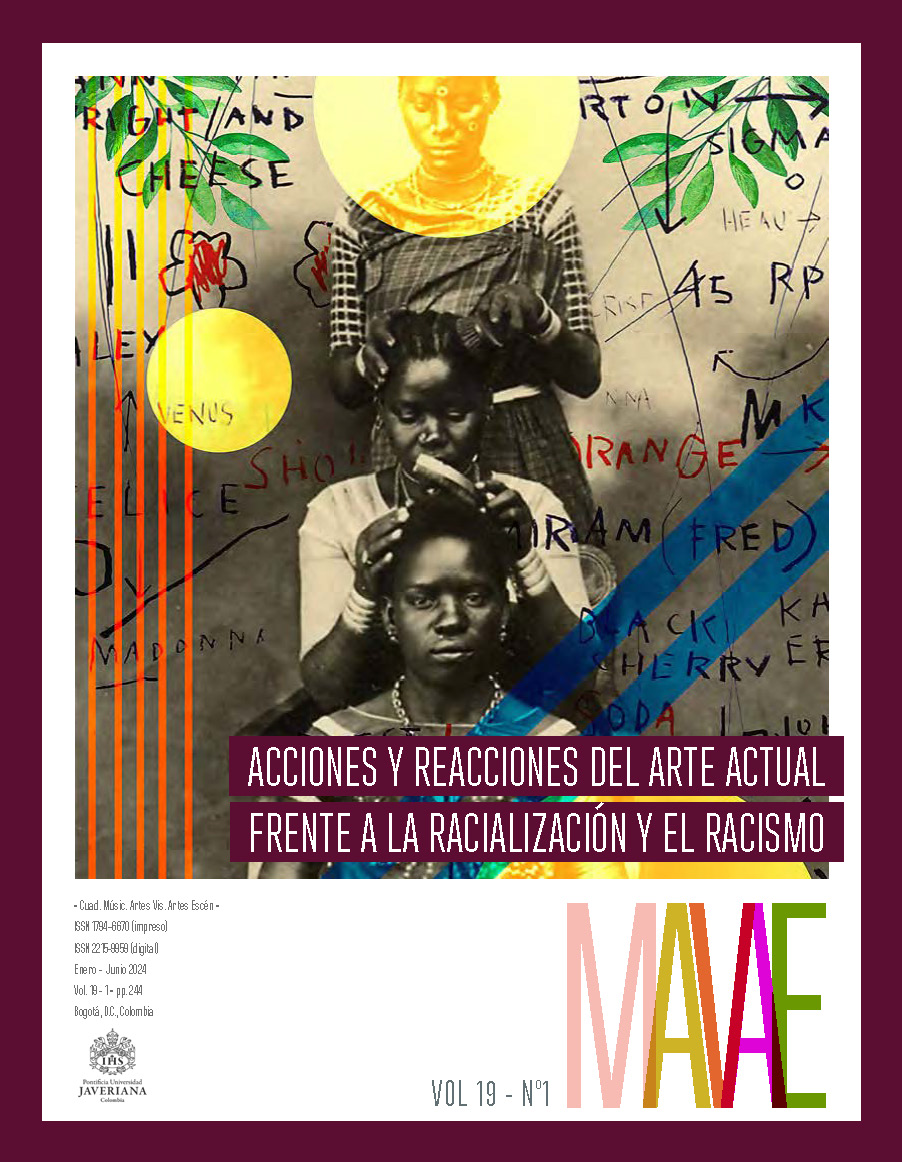Artificial intelligence, racialization, and art resistance
##plugins.themes.bootstrap3.article.details##
Contemporary culture is shaped by information technology, in particular, artificial intelligence applications. One of the goals of this paper is to analyze how artistic practices could use machine learning algorithms as racial resistance. In addition, to remove from the black box how these applications work by relating the technical process that artists face. It will analyze the aesthetic and narrative perception around artificial intelligence, racism in the creation of data sets to train these algorithms and the possibilities that artificial intelligence opens to rethink concepts such as intelligence and imagination. This research is framed from the posthumanist subjectivity that uses critical imagination to question the classic and Eurocentric definition of human as a measure of what surrounds us. Finally, I will describe the work of the contemporary artist Linda Dounia and her interest in incorporating her experience as a Senegalese woman in the training of Generative Adversarial Networks models to reflect on her identity.
Artificial Intelligence, Critical Imagination, Generative art, AfrofuturismInteligencia artificial, imaginación crítica, arte generativo, afrofuturismoInteligência Artificial, Imaginação Crítica, Arte Gerativa, Afrofuturismo
Atanasoski, Neda, and Kalindi Vora. Surrogate Humanity: Race, Robots, and the Politics of Technological Futures. Durham: Duke University Press, 2019.https://resolver.ebscohost.com/Redirect/PRL?EPPackageLocationID=1 1 2 7 0 8 7 . 1 9 9 6 4 3 6 1 . 4 9 2 8 1 5 4 8 &epcustomerid=s9001366. Globales e Historias Locales: Origen y
Desarrollo de una Propuesta Educativa en un Museo Interactivo de Ciencias y Tecnologías en el Sur
BBC News. 2023. “Artificial Intelligence Could Lead to Extinction, Experts Warn,” May 30, 2023, sec. Technology. https://www.bbc.com/news/uk-65746524.
Bognini, Karafa, Loyapin Bondé, Sié Sylvestre Da, Abisha Mapendembe, and Roch Yao Gnabeli. 2023. “Promoting Private Forests for
Biodiversity Conservation and Ecosystems Restoration in the Sahel Region.” Nature Conservation 53 (June): 17–38. https://doi.
org/10.3897/natureconservation.53.99313.
Bourke, Joanna. 2011. What It Means to Be Human : Reflections from 1791 to the Present. London : Virago Press. http://archive.org/details/whatitmeanstobeh0000bour.
Braidotti, Rosi. The Posthuman. 2013. Oxford: Wiley. http://search.ebscohost.com/login.aspxdirect=true&scope=site&db=nlebk&db=nlabk&
AN=653028.
Burget, Mirjam, Emanuele Bardone, and Margus Pedaste. “Definitions and Conceptual Dimensions of Responsible Research and Innovation: A Literature Review.” Science and Engineering Ethics 23, no. 1 (February 2017): 1–19. https://doi.org/10.1007/s11948-016-9782-1.
Brauner, Philipp, Alexander Hick, Ralf Philipsen, and Martina Ziefle. 2023.“What Does the Public Think about Artificial Intelligence?—A
Criticality Map to Understand Bias in the Public Perception of AI.” Frontiers in Computer Science 5 (March) 1-12. https://doi.org/10.3389/fcomp.2023.1113903.
Broussard, Meredith. 2023. More than a Glitch: Confronting Race, Gender,and Ability Bias in Tech. Cambridge, Massachusetts: The MIT Press.
Crawford, Kate. 2021. The Atlas of AI: Power, Politics, and the Planetary Costs of Artificial Intelligence. New Haven: Yale University Press.https://doi.org/10.2307/j.ctv1ghv45t.
Corbett-Davies, Sam, Emma Pierson, Avi Feller, Sharad Goel, and Aziz Huq. 2017. “Algorithmic Decision Making and the Cost of Fairness.”https://doi.org/10.48550/arXiv.1701.08230
Curatola, Marco, and José Carlos de la Puente Luna ed. 2013. El quipu colonial : estudios y materiales. Perú: Pontificia Universidad Católica del Perú. Fondo Editorial. https://repositorio.pucp.edu.pe/index/handle/123456789/173101.
Darcy, Oliver. 2023. “Experts Are Warning AI Could Lead to Human Extinction. Are We Taking It Seriously Enough? | CNN Business.”
CNN. May 31, 2023. https://www.cnn.com/2023/05/30/media/artificial-intelligence-warning-reliable-sources/index.html.
D’Ignazio, Catherine, and Lauren F. Klein. 2020. Data Feminism. Cambridge, Massachusetts: The MIT Press.https://search.ebscohost.com/login.aspx?direct=true&scope=site&db=nlebk&db=nlabk&AN=2378911.
Haraway, Donna J., ed. 2016. “Playing String Figures with Companion Species” in Staying with the Trouble: Making Kin in the Chthulucene,0. Duke University Press. https://doi.org/10.1215/9780822373780-002.— 1988. “Situated Knowledges: The Science Question in Feminism and the Privilege of Partial Perspective.” Feminist Studies 14 (3): 575–99.https://doi.org/10.2307/3178066.
Harris, Daryl B. 2005. “Postmodernist Diversions in African American Thought.” Journal of Black Studies 36 (2): 209–28. https://doi.
org/10.1177/0021934704266077.
Hayles, N. Katherine. Unthought: The Power of the Cognitive Nonconscious.2017. Chicago: The University of Chicago Press.
Hyland, Sabine. 2020. “Subject Indicators and the Decipherment of Genreon Andean Khipus.” Anthropological Linguistics 62 (2): 137–58.https://doi.org/10.1353/anl.2020.0004.— n.d. “Guardianes de los Khipus.” Google Arts & Culture. Accessed July 10, 2023. https://artsandculture.google.com/project/khipus.
Koenecke, Allison, Andrew Nam, Emily Lake, Joe Nudell, Minnie Quartey, Zion Mengesha, Connor Toups, John R. Rickford, Dan Jurafsky, and Sharad Goel. 2020. “Racial Disparities in Automated Speech Recognition.” Proceedings of the National Academy of Sciences 117 (14): 7684–89. https://doi.org/10.1073/pnas.1915768117.
Lavazza, Andrea, and Mirko Farina. 2023. “Infosphere, Datafication, and Decision-Making Processes in the AI Era.” Topoi 42 (3): 843–56.https://doi.org/10.1007/s11245-023-09919-0.“Liminal Space.” n.d. Unit London. Accessed July 4, 2023. https://unitlondon.com/exhibitions/liminal-space-online-group-exhibition/.“AI Art: How Artists Are Using and Confronting Machine Learning | HOW TO SEE LIKE A MACHINE.” The Museum of Modern Art. March 15,2023. Video, AI Art: How artists are using and confronting machine learning | HOW TO SEE LIKE A MACHINE
Neri, Hugo, and Fabio Cozman. 2020. “The Role of Experts in the Public Perception of Risk of Artificial Intelligence.” AI & SOCIETY 35 (3): 663–73. https://doi.org/10.1007/s00146-019-00924-9.
Roose, Kevin. 2023. “A.I. Poses ‘Risk of Extinction,’ Industry Leaders Warn.” The New York Times, May 30, 2023, sec. Technology. https://www.nytimes.com/2023/05/30/technology/ai-threat-warning.html.
Salinas, Francisco Simon. 2022. “Feminismos revolucionarios: socialismo y patriarcado en Alicia Galaz y Cecilia Vicuña.” Aisthesis, (72), 233-253. https://dx-doi-org.proxy.library.cornell.edu/10.7764/aisth.72.13
Shahriar, Sakib. 2022. “GAN Computers Generate Arts? A Survey on Visual Arts, Music, and Literary Text Generation Using Generative
Adversarial Network.” Displays 73 (July): 102237. https://doi.org/10.1016/j.displa.2022.102237.

This work is licensed under a Creative Commons Attribution 4.0 International License.


